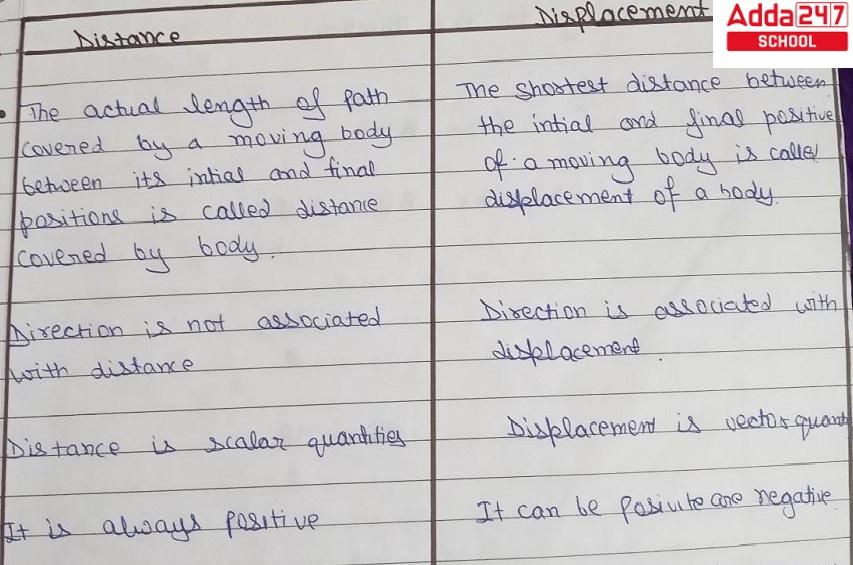Table of Contents
Distance and displacement are two closely related words in physics, although they have different meanings. The length of an object’s route, regardless of direction, is defined as distance. Displacement is the shortest distance between an object’s original and final positions, taking into consideration the direction of motion. In other words, distance is a scalar quantity, but displacement is a vector quantity. This means that distance just has magnitude, whereas displacement has both magnitude and direction. For example, if an object travels in a circle, the distance traveled is the circumference of the circle, but the displacement is 0 since the object returns to where it originated. difference between distance and displacement explained in simple words.
Difference Between Distance and Displacement
The difference between distance and displacement is one of the most frequently asked and perplexing problems in Physics. In addition, issues such as distinguishing between distance and displacement are popular in tests. To comprehend the distinctions, it is necessary to be well-versed in their underlying principles. Understanding the principles of distance and displacement will help you grasp these distinctions.
Difference Between Distance and Displacement for Class 9
Following are the 10 important differences between distance and displacement.
| Sl. No. | Differentiating Property | Distance | Displacement |
|---|---|---|---|
| 1 | Definition | The complete length of the path between any two points is called distance. | Displacement is the direct length between any two points when measured along the minimum path between them. |
| 2 | Denotation | d | s |
| 3 | Direction Consideration | To calculate distance, the direction is not considered. | To calculate displacement, the direction is taken into consideration. |
| 4 | Quantity | Distance is a scalar quantity as it only depends upon the magnitude and not the direction. | Displacement is a vector quantity as it depends upon both magnitude and direction. |
| 5 | Route Information | Distance gives the detailed route information that is followed while travelling from one point to another. | As displacement refers to the shortest path, it does not give complete information on the route. |
| 6 | Formula | Speed × Time | Velocity × Time |
| 7 | Possible Values | The distance can only have positive values. | Displacement can be positive, negative, and even zero. |
| 8 | Indication | Distance is not indicated with an arrow. | Displacement is always indicated with an arrow. |
| 9 | Measurement in Non-straight Path | The distance can be measured along a non-straight path. | Displacement can only be measured along a straight path. |
| 10 | Path Dependence | Distance depends upon the path i.e. it changes according to the path taken. | Displacement does not depend upon the path and it only depends upon the initial and final position of the body. |
Differentiate Between Distance and Displacement in Hindi
The table below consists of difference between distance and displacement in Hindi.
| सीरा नं. | विभेदक गुणवत्ता | दूरी | विस्थापना |
|---|---|---|---|
| 1 | परिभाषा | किसी भी दो बिंदुओं के बीच रास्ते की पूर्ण लंबाई को ‘दूरी’ कहते हैं। | ‘विस्थापना’ उन दो बिंदुओं के बीच सीधे लंबाई को दर्शाता है जो उन्हें आपस में जोड़ने वाले रास्ते के अनुसार मापी जाती है। |
| 2 | संकेतन | d | s |
| 3 | दिशा ध्यान | दूरी की गणना करने के लिए दिशा को नहीं ध्यान में लिया जाता है। | विस्थापना की गणना करते समय दिशा को ध्यान में रखा जाता है। |
| 4 | मात्रा | दूरी एक सकल मात्रा है क्योंकि इसमें केवल मात्रा और दिशा का ध्यान नहीं होता है। | विस्थापना एक वेक्टर मात्रा है क्योंकि इसमें मात्रा और दिशा दोनों का ध्यान होता है। |
| 5 | रास्ता सूचना | दूरी यात्रा करते समय अनुशासित रास्ते की विस्तृत जानकारी प्रदान करती है। | विस्थापना उन्हें सबसे छोटे रास्ते को दर्शाती है, इसलिए इसमें पूरी रास्ते की जानकारी नहीं होती। |
| 6 | सूत्र | गति × समय | वेग × समय |
| 7 | संभावित मूल्य | दूरी केवल सकारात्मक मूल्य हो सकती है। | विस्थापना सकारात्मक, नकारात्मक, और शून्य भी हो सकती है। |
| 8 | प्रतीक | दूरी को एक तीर के साथ नहीं दर्शाया जाता है। | विस्थापना हमेशा एक तीर के साथ दर्शाई जाती है। |
| 9 | गैर-सीधी पथ मापन | दूरी को गैर-सीधे पथ पर मापा जा सकता है। | विस्थापना को केवल सीधे पथ पर ही मापा जा सकता है। |
| 10 | पथ निर्भरता | दूरी पथ पर निर्भर करती है, अर्थात् यह रास्ते के अनुसार बदलती है। | विस्थापना पथ पर निर्भर नहीं करती और यह केवल शरीर के आरंभिक और अंतिम स्थान पर निर्भर करती है। |
What is Distance?
The measurement of distance between two objects or points. It is a scalar quantity, meaning it has simply magnitude and no direction. The metre (m) is the SI unit of distance.
There are numerous methods for measuring distance, including:
- Direct measurement is the most accurate method of measuring distance and is commonly used in surveying.
- Indirect measurement: This method estimates distance by using other measurements, such as the angle between two places or the length of a shadow.
Instrumental measurement: This method measures distance with an instrument such as a laser rangefinder or a tape measure.Distance is a key notion in a variety of domains, including physics, engineering, and navigation. It is also utilised in everyday life, such as when calculating the distance between two cities or the distance travelled by car.
What is Displacement?
The displacement of an object is the change in its position. It is a vector quantity, which implies it contains magnitude as well as direction. The magnitude of displacement is the shortest distance between the beginning and final positions of an object. The displacement direction is the direction from the object’s initial to final position. In physics, displacement is frequently used to describe the motion of objects. For example, if an object moves from point A to point B, its displacement is the vector that connects the two positions. The displacement’s magnitude is the distance between points A and B, and the displacement’s direction is the direction from point A to point B.
Understanding Distance with an Example
Riya plans to take a lengthy drive one day. Instead of thinking about a path, she wanders around the city.Distance = Speedtime, and the distance unit is metres -‘m’.What do you take away from this example?So, Riya’s car is passing through certain spots, and let us link two of them, and the other two points her car passed through in the following order:The first path is AB, while the second path is GH. The distances Riya traversed at time t1 and t2 are represented by the two paths AB and GH.Please keep in mind that one of Riya’s activities is simply “roaming” throughout the city, without regard for the “types of paths” she travelled.
Understanding Displacement with a example
Assume a new scenario in which the same lady, Riya, is rushing to her office. She was exhausted after a long travel last night and awoke late. She has an important project due and is running late.Now, she’s looking for a way to get there 30 minutes earlier than usual, so what’s the fastest route? That quickest path is nothing more than the “displacement.”We deduced from this that Riya must evaluate the type of road she will take in order to be at the office on time. When we consider the type of path, we see that it is displacement.We can determine the path an object takes as well as its direction.
This path’s average velocity = total displacement/total time taken
The velocity is computed in metres per second here.
Seconds and minutes
Measurement in millimetres.
As a result of our examples on distance and displacement, we can conclude that distance has only one magnitude, regardless of direction. However, displacement considers both the magnitude and direction of an object’s path.As a result, distance is a scalar quantity, but displacement is a vector quantity. Displacement can be positive, negative, or zero, but distance is always positive or zero.
Difference between Distance and Displacement Examples
Question 1: A car travels 100 meters east and then 100 meters west. What is the car’s displacement?
Solution: The car’s displacement is zero meters. This is because the car’s final position is the same as its initial position.
Question 2: A person walks 50 meters north and then 25 meters south. What is the person’s displacement?
Solution: The person’s displacement is 25 meters north. This is because the direction of the displacement is the direction from the person’s initial position to their final position.
Question 3: A ball rolls down a hill and comes to a stop 100 meters from its starting point. What is the ball’s displacement?
Solution: The ball’s displacement is 100 meters. This is because the ball’s final position is 100 meters from its starting point, regardless of the direction of the ball’s motion.
What is 5 Difference Between Displacement and Distance Class 9
For a Class 9 level understanding, here are five key differences between displacement and distance:
Definition:
Distance: The total path length covered by an object, regardless of direction.
Displacement: The shortest straight-line distance from the initial to the final position of the object, along with the direction.
Nature: Distance: Scalar quantity (has magnitude only).
Displacement: Vector quantity (has both magnitude and direction).
Path Dependence: Distance: Depends on the actual path taken.
Displacement: Does not depend on the path taken, only on the initial and final positions.
Value: Distance: Always positive and never decreases.
Displacement: Can be positive, negative, or zero, depending on the direction relative to the starting point.
Examples: Distance: If you walk 5 km in a circle and return to your starting point, the distance is 5 km.
Displacement: For the same scenario, the displacement is 0 km because the initial and final positions are the same.
Other Related Posts –


 IIT JEE Advanced 2025 Increases Number o...
IIT JEE Advanced 2025 Increases Number o...
 UP Board Exam Date 2025 Class 10, 12- Do...
UP Board Exam Date 2025 Class 10, 12- Do...
 CUET Syllabus 2025 for Science Students,...
CUET Syllabus 2025 for Science Students,...





























